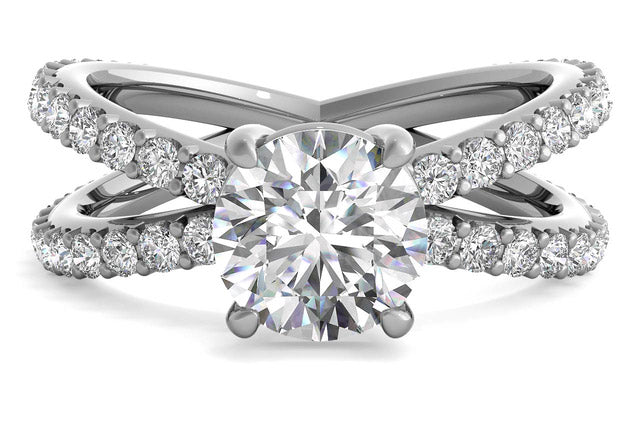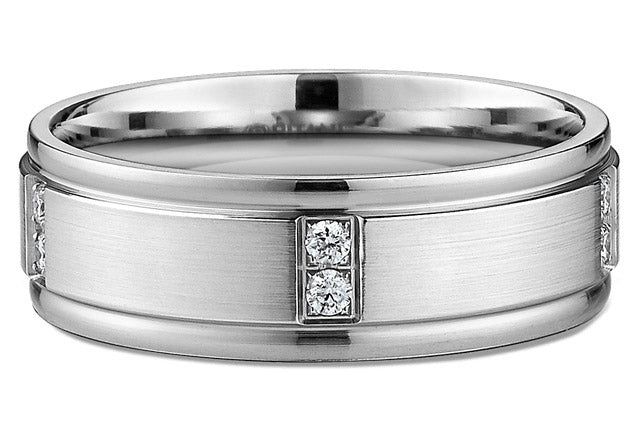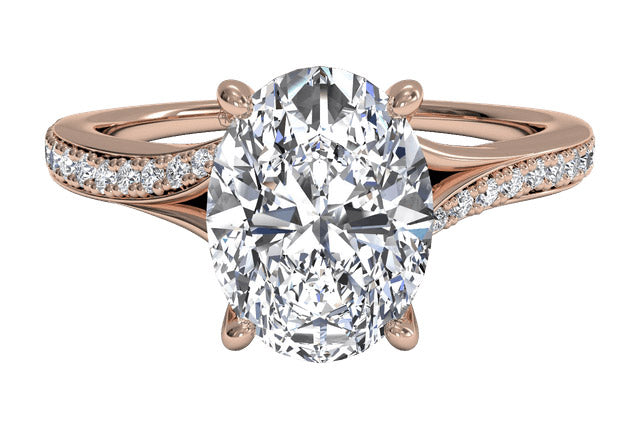March 17, 2023
Engagement and Wedding Ring Metals

With so many options to choose from and factors to consider, deciding on your ideal wedding ring metal can feel overwhelming. Should you go with tried-and-true yellow gold, or should you invest in something more adventurous? Which metals are the most durable and will stand up best to everyday wear and tear?
Knowing your engagement and wedding band metals can be invaluable in guiding your decision, as different materials offer different benefits and longevities. Read on to learn more about the metals that make up our favorite classic and modern wedding bands.
Classic Metals
While traditional metals like silver and gold have changed little since they first hit the jewelry scene thousands of years ago, modern designs offer fresh appeal, and today’s classic ring metals shine brighter than ever before. Here is a glimpse at some of our favorite timeless metals.
Yellow Gold
Gold has been used to create wedding bands for centuries and, fortunately, today’s yellow gold bands look better than ever. Yellow gold provides a warm, rich glow and has been a go-to wedding band metal for the last several decades. It’s important to note the difference between the words “karat” and “carat”. “Karat” denotes a metal’s purity, while “carat” is used exclusively to measure the weight for diamonds and precious gems. Though available in both 18 karat (18k) and 14 karat (14k) fineness levels, 18k is most common for yellow gold. 24 karat is considered to be pure gold, however it is typically too soft to use for jewelry.
Ritani’s ring collections offer yellow gold in 18k only, as it is the more durable and hypoallergenic of the yellow golds.
|
 |
 |
| Price Range: $$$$ | Durability: ★★★★ |
| Average Lifespan: 20-30 years | Hypoallergenic Score: ★★★★ |
White Gold
White gold is another classic metal and a fantastic alternative to yellow gold. While the warmth of yellow gold can look too harsh on some, white gold complements a wide range of skin tones. Although it closely resembles platinum and silver, this metal is slightly warmer in hue than other options. It looks just as lustrous as platinum when fresh from your jeweler, but typically requires re-plating over time. Rhodium is usually used for re-plating white gold, as it helps to enhance strength and shine.
 |  |
| Price Range: $$$$ | Durability: ★★★★ |
| Average Lifespan: 7-12 years | Hypoallergenic Score: ★★★★ |
Platinum
Strength meets beauty in platinum wedding and engagement rings, which are heavier and longer-lasting than their white gold counterparts. The two metals can look quite similar when new; however, platinum will retain its brilliance and never requires re-plating over time. Platinum is the definition of timeless, which makes it a symbolic and romantic metal suitable for both engagement and wedding bands. It is also an uncommon material, approximately 30 times more rare than gold. If you are looking for a durable ring as unique and everlasting as your love, you may meet your match in platinum.
 |  |
| Price Range: $$$$ | Durability: ★★★★ |
| Average Lifespan: 30-40 years | Hypoallergenic Score: ★★★★ |
Sterling Silver
Rounding out the classic metals group is the understated sterling silver. Although it is often overlooked because of its softness and malleability, silver can still be used to create stunning wedding and engagement rings. Even though it is considered a classic material, this metal is heralded for its sleek and modern aesthetic which complements a wide variety of skin tones. Because pure silver is too delicate to stand up to decades of wear, many rings are coated with rhodium to enhance strength and resist damage.
 |  |
| Price Range: $$$ | Durability: ★★★ |
| Average Lifespan: 12-20 years | Hypoallergenic Score: ★★★★ |
Modern Metals
Trends come and go, but today’s engagement and wedding rings are designed to last. While they may be made of unconventional materials, modern metals offer a winning combination of style and performance. Some, like rose gold, provide an welcome blush of warm color. Others, like cobalt and palladium, are created to sooth sensitive skin. All provide stunning looks that rival classic metals while simultaneously giving a nod to modernity.
Rose Gold
Rose gold is not necessarily a new material in the fine jewelry world, but it has recently surged in popularity, especially in engagement ring bands. Typically found in 18k fineness, rose gold is made up of three parts gold and one part copper alloy. The resulting rosy hue is modern and romantic, and looks stunning when paired with diamonds. Already a current favorite for engagement rings, thanks to its soft brilliance, this metal also works well for men’s and women’s wedding bands. Although it is certainly trendy, this refreshingly playful metal will never go out of style.
 |  |
| Price Range: $$$$ | Durability: ★★★★ |
| Average Lifespan: 20-30 years | Hypoallergenic Score: ★★★★ |
Cobalt
Cobalt is unlike any other alloy metal on the engagement and wedding ring market. This material is dark, moody and extremely durable. It rivals platinum in its capacity to resist damage and wear. In fact, it is one of the most scratch-resistant metals available. Thanks to its ability to ward off oxidation, cobalt rarely requires re-plating over time. While its deep, rich hue may be overbearing for some, we think this metal looks especially striking on men’s wedding bands. Cobalt is also ideal for those with sensitive skin, as it is unmatched in its hypoallergenic properties.

| Price Range: $$$ | Durability: ★★★★ |
| Average Lifespan: 30-40 years | Hypoallergenic Score: ★★★★ |
Tungsten
Tungsten is extremely durable as well as hypoallergenic, making it a great choice for wedding rings. Tungsten measures between 8 and 9 on the Mohs scale, so it is even harder than platinum and cobalt and nearly as hard as diamonds. Tungsten is exceptionally scratch resistant, and won’t bend, tarnish, or require replating. It’s very easy to clean. Because tungsten is so hard, it can also be brittle, so these wedding rings cannot be resized. However, we can exchange your band for a different size once within the first 12 months of purchase at no cost to you.

| Price Range: $$$ | Durability: ★★★★ |
| Average Lifespan: Due to its newness in jewelry, we don’t know its exact longevity yet. | Hypoallergenic Score: ★★★★ |
Tantalum
Discovered in 1802, tantalum is a very rare gray metal that is incredibly durable and resistant to scratches. It is also hypoallergenic. This metal can be resized. It’s also malleable enough to be easily cut off in an emergency. These low-maintenance rings will never need to be replated and are easy to clean.

| Price Range: $$$ | Durability: ★★★★ |
| Average Lifespan: Due to its newness in jewelry, we don’t know its exact longevity yet. | Hypoallergenic Score: ★★★★ |


